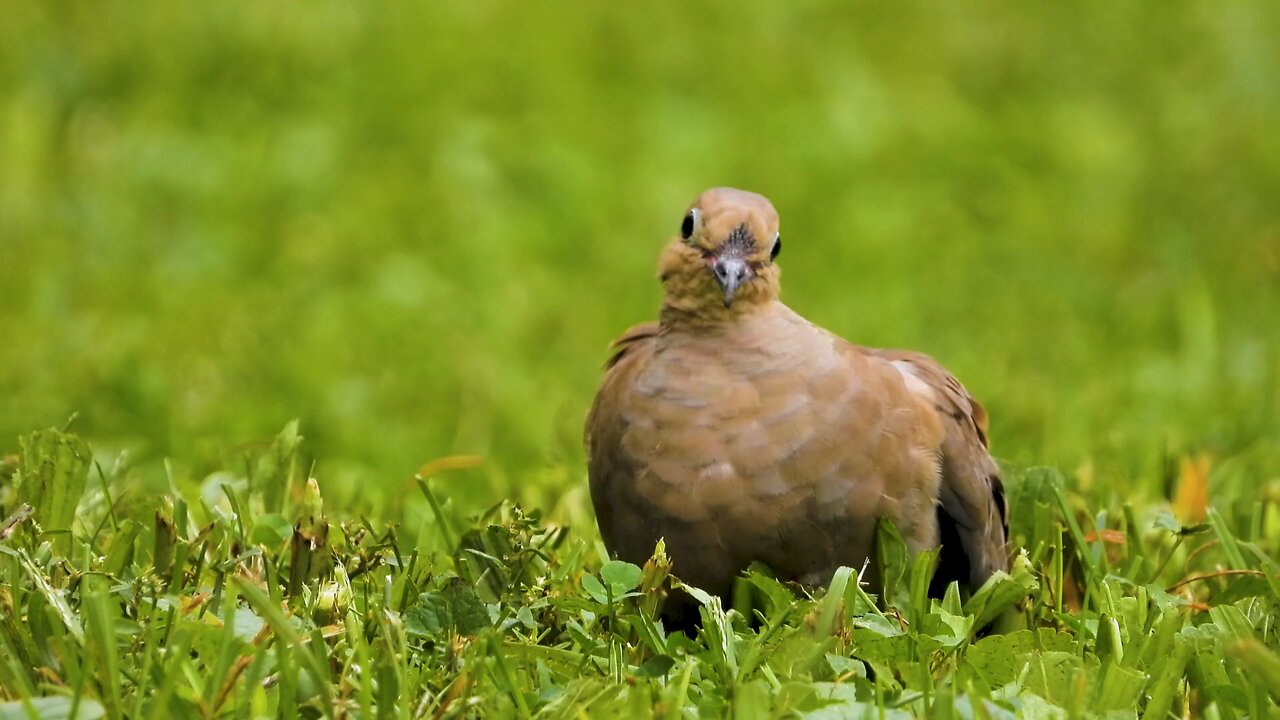Premium Only Content

"The Peaceful Presence of Mourning Doves"
The bird in your image appears to be a Mourning Dove (*Zenaida macroura*), a species widely recognized for its gentle nature and soft, mournful call. Here’s a more detailed description:
### **Physical Characteristics:**
- **Size and Shape**: Mourning Doves are medium-sized birds, typically around 9 to 13 inches (23 to 34 cm) in length, with a wingspan of about 17 to 18 inches (43 to 45 cm). They have a slender, streamlined body, a small head, and a long, tapered tail with white edges.
- **Plumage**: Their overall coloration is light grayish-brown, with subtle hints of pink on the chest and underparts. The wings have black spots, and the tail has white edges that are particularly noticeable during flight. Their eyes are dark, and they have a distinctive, delicate blue-gray eye-ring.
- **Bill and Feet**: The bill is relatively small and dark, while their legs and feet are a pinkish-red color.
### **Behavior:**
- **Feeding**: Mourning Doves primarily eat seeds, making them granivores. They forage on the ground in open areas such as fields, gardens, and lawns, where they feed on a wide variety of seeds, including those from grasses, weeds, and cultivated grains. They have a high metabolic rate, and it’s common for them to consume up to 20% of their body weight in seeds daily.
- **Flight**: Their flight is swift and direct, with strong wingbeats. Mourning Doves are also known for making a characteristic whistling sound with their wings when they take off, which is thought to be a form of communication or a way to startle predators.
- **Vocalization**: The mourning dove's call is a soft, mournful "coo-ah, coo, coo, coo," which is often mistaken for an owl's hooting. This call is used by males to attract a mate or to establish territory.
### **Habitat and Distribution:**
- **Range**: Mourning Doves are widespread across North America, including in Canada, the United States, and Mexico. They are highly adaptable and can be found in a variety of habitats, from rural farmland to urban gardens and parks.
- **Nesting**: These birds build simple nests, usually in trees, shrubs, or sometimes on the ground. The nests are often flimsy and constructed with twigs and grass. Mourning Doves typically lay two white eggs, and both parents take turns incubating them.
### **Reproduction:**
- **Breeding Season**: Mourning Doves are prolific breeders, often raising several broods per year, especially in warmer climates. The breeding season usually begins in early spring and can continue into the fall.
- **Parental Care**: Both parents are involved in caring for the young. After hatching, the chicks (called squabs) are fed "pigeon milk," a nutrient-rich secretion produced by the parents. The squabs grow quickly and are usually ready to leave the nest in about two weeks.
### **Conservation Status:**
- Mourning Doves are abundant and not considered threatened. They are one of the most common and widespread bird species in North America, with an estimated population of 350 million individuals. Their adaptability to different environments has helped maintain their numbers.
### **Cultural Significance:**
- Mourning Doves have been a symbol of peace and love in many cultures. Their soft, cooing calls and gentle demeanor make them a favorite among birdwatchers and nature enthusiasts.
This species is a wonderful example of a bird that has successfully adapted to human-altered landscapes while maintaining its natural behaviors and characteristics.
-
 LIVE
LIVE
Right Side Broadcasting Network
9 days agoLIVE: President Donald J. Trump Keynotes TPUSA’s AmFest 2024 Conference - 12/22/24
23,007 watching -
 4:31
4:31
CoachTY
15 hours ago $10.62 earnedCOINBASE AND DESCI !!!!
45.2K6 -
 10:02
10:02
MichaelBisping
14 hours agoBISPING: "Was FURY ROBBED?!" | Oleksandr Usyk vs Tyson Fury 2 INSTANT REACTION
7.27K7 -
 8:08
8:08
Guns & Gadgets 2nd Amendment News
2 days ago16 States Join Forces To Sue Firearm Manufacturers Out of Business - 1st Target = GLOCK
59.5K60 -
 10:17
10:17
Dermatologist Dr. Dustin Portela
1 day ago $10.07 earnedOlay Cleansing Melts: Dermatologist's Honest Review
69.8K3 -
 1:02:20
1:02:20
Trumpet Daily
2 days ago $28.93 earnedObama’s Fake World Comes Crashing Down - Trumpet Daily | Dec. 20, 2024
45.1K39 -
 6:29
6:29
BIG NEM
23 hours agoCultivating God Mode: Ancient Taoist NoFap Practices
36.9K9 -
 30:53
30:53
Uncommon Sense In Current Times
1 day ago $8.86 earned"Pardon or Peril? How Biden’s Clemency Actions Could Backfire"
56.3K4 -
 40:01
40:01
CarlCrusher
21 hours agoSkinwalker Encounters in the Haunted Canyons of Magic Mesa - ep 4
52.4K2 -
 59:44
59:44
PMG
1 day ago $6.77 earned"BETRAYAL - Johnson's New Spending Bill EXPANDS COVID Plandemic Powers"
58.7K22